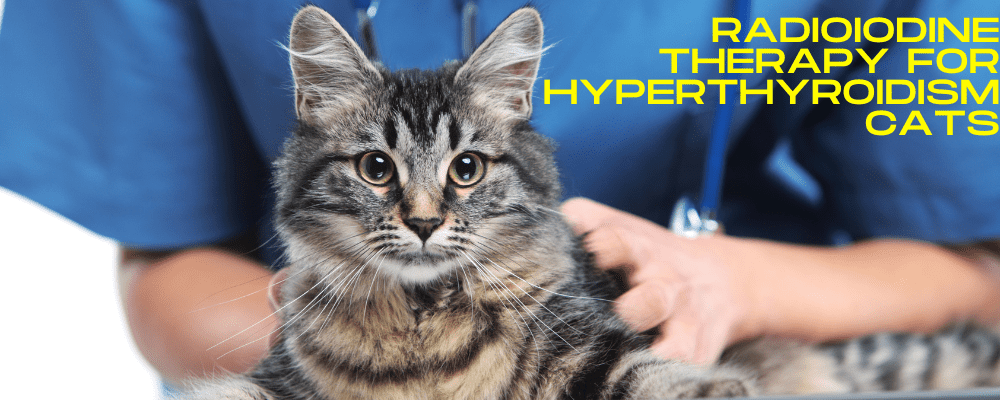What is Hyperthyroidism?
The thyroid gland is located in the neck and plays a very important role in regulating the body’s rate of metabolism. Hyperthyroidism is a disorder characterized by the overproduction of thyroid hormone and a subsequent increase in the metabolic rate. This is a fairly common disease of older cats. Although the thyroid gland enlarges, it is usually a nonmalignant change (benign). Less than 2% of hyperthyroid cases involve a malignancy.
Many organs are affected by this disease, including the heart. The heart is stimulated to pump faster and more forcefully; eventually, the heart enlarges like any other muscle that is exercised a lot. The increased pumping pressure leads to a greater output of blood and high blood pressure. About 80% of cats with hyperthyroidism have high blood pressure.
Causes
Advancing age is the main factor that increases a cat’s risk for hyperthyroidism. Environmental and dietary risk factors have been investigated and may play a role in predisposing cats to hyperthyroidism, though the specific mechanisms are not known.
No individual breed is known to be at increased risk, but the Siamese appears to have a 10-fold lower risk of developing hyperthyroidism than other breeds.
Clinical Signs
The typical cat with hyperthyroidism is middle-aged or older; on the average, affected cats are about 12 years of age. The most consistent finding with this disorder is a loss of weight secondary to the increased rate of metabolism. The cat tries to compensate for this with an increased appetite. In fact, some of these cats have a ravenous appetite and will literally eat anything in sight! Despite the increased intake of food, most cats gradually lose weight. The weight loss may be so gradual that some owners will not even realize it has occurred. Affected cats often drink a lot of water and urinate a lot. There may be periodic soft stool or diarrhea, and the hair coat may be unkempt. In some cats, a loss of appetite develops as the disease progresses.
Two secondary complications of this disease can be significant. These include hypertension (high blood pressure) and a heart disease called thyrotoxic cardiomyopathy. Hypertension develops as a consequence of the increased pumping pressure of the heart. In some cats, blood pressure can become so high that retinal hemorrhage or detachment will occur and result in sudden blindness. The heart problems develop because the heart enlarges and thickens to meet the increased metabolic demands. Both hypertension and heart muscle thickening are reversible with appropriate treatment of the disease.
Diagnosis
In most instances, diagnosis of this disease is relatively straightforward. Since hyperthyroidism is so common, routine screening blood tests usually measure the level of one of the thyroid hormones, called thyroxine (or T4). Usually, the T4 level is so high that there is no question as to the diagnosis.
Occasionally, a cat suspected of having hyperthyroidism will have T4 levels within the upper range of normal cats. When this occurs, a second test is performed. This might be a FT4 or a T3 suppression test. If this is not diagnostic, a thyroid scan can be performed at a veterinary referral center or the T4 could be measured again in a few months.
Another thing that can happen is an increase in the size of one or both thyroid lobes. If they can be palpated (felt) during the physical exam, the disease is very likely.
A few other diagnostic tests are recommended before treatment. These tests are needed to evaluate the overall health of the cat and predict the chances for complications. These tests include a CBC, chemistry profile, urinalysis, and blood pressure measurement. A chest x-ray or cardiac ultrasound may be needed if there is evidence of heart disease.
Radioiodine Therapy
The most effective way to destroy all of the abnormal thyroid tissue is with radioactive iodine therapy. It usually causes no damage to normal thyroid tissue or to the nearby parathyroid gland. The treatment consists of one injection, followed by 3-4 days of hospitalization to allow the radioactivity to attenuate. This small amount of radiation does not cause hair loss, vomiting or any other side effects. Ninety-six percent of the patients treated with radioactive iodine require no retreatment and no thyroid supplementation.
Prognosis
Because less than 2% of these cats have cancerous growths of the thyroid gland, treatment is usually very successful. Recurrence of the disease is a possibility, but it is uncommon after radioactive iodine therapy.
One potential consequence of treating hyperthyroidism is the unmasking of chronic kidney disease. In some geriatric cats, kidney function has declined with age. When hyperthyroidism is present, it helps the cat partially compensate for this loss of kidney function. The hypertension that accompanies hyperthyroidism serves to increase blood flow to the kidneys. When the hyperthyroid state is treated, renal blood flow returns to normal and the cat may show signs of kidney failure. This occurs in only a small number of hyperthyroid cats and is most likely if kidney function tests before treatment are abnormal.
Many owners of cats with hyperthyroidism are hesitant to have radiation therapy because of their cat’s advanced age. But remember, old age is not a disease. The outcome following radiation therapy is usually very positive, and most cats have a very good chance of returning to an excellent state of health.
Prevention
There are no known preventive measures, but middle-aged and geriatric cats should all receive a complete physical examination and lab work by a veterinarian every year.
